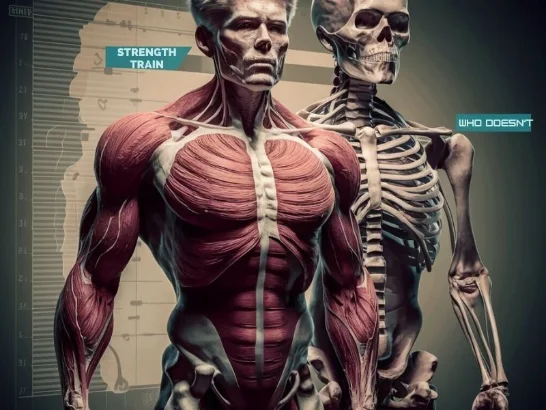Ever feel like you’re constantly tired, even when you’re getting enough sleep? Or maybe you’re worried about your bones getting weaker as you age?
Strength training might be the unexpected solution you’ve been looking for. And no, you don’t have to become a bodybuilder to reap the amazing benefits!

- Strength Training: More Than Just Big Muscles
- Why Strength Training Matters to You
- Strength Training’s Impact on Your Physical Health: A Full-Body Tune-Up
- Strength Training’s Impact on Your Mental Health: A Mood-Boosting Powerhouse
- Addressing Your Strength Training Concerns: Busting Myths and Answering FAQs
- Conclusion: Unleash Your Inner Strength and Embrace a Healthier Life
Strength Training: More Than Just Big Muscles
Strength training isn’t just about getting ripped or lifting heavy weights. It’s a cornerstone of overall health, with benefits that go far beyond aesthetics. We’re talking about boosting your metabolism, fortifying your bones, improving your heart health, and even giving your mood a major lift.
What We’ll Uncover
In this guide, we’ll dive deep into the science-backed reasons why strength training is essential for everyone – young or old, man or woman. We’ll explore how it:
- Transforms your body composition: Building muscle and shedding fat for a healthier, more energetic you.
- Protects your bones: Keeping your skeleton strong and resilient as you age.
- Boosts your metabolism: Helping you burn more calories even when you’re not working out.
- Strengthens your heart: Reducing your risk of heart disease and improving cardiovascular fitness.
- Enhances your mental well-being: Decreasing stress, anxiety, and even boosting brainpower.

Why Strength Training Matters to You
You might be wondering, “Is strength training really for me?” The answer is a resounding YES! The U.S. Department of Health and Human Services recommends strength training for all adults, regardless of age or fitness level. It’s never too late to start reaping the rewards.

Whether you’re a beginner looking to kickstart your fitness journey or a seasoned athlete wanting to optimize your performance, strength training has something to offer you.
Ready to Get Stronger, Healthier, and Happier?
Join us as we debunk common misconceptions, answer your burning questions, and reveal the incredible power of strength training to transform your life. Let’s get started on the path to a stronger, healthier, and more confident you!
Strength Training’s Impact on Your Physical Health: A Full-Body Tune-Up
Strength training isn’t just about sculpted biceps or a toned physique. It’s a full-body tune-up that benefits your muscles, bones, heart, metabolism, and even your balance. In this section, we’ll break down how strength training works its magic on your physical health, giving you a deeper understanding of why it’s so much more than just lifting weights.

Builds and Maintains Muscle Mass
Let’s start with the most obvious benefit: muscle building. Strength training puts your muscles under tension, creating tiny tears in the muscle fibers. These tears then repair and rebuild, resulting in stronger and larger muscles.

But the benefits go beyond just looking good. Muscle mass is a metabolically active tissue, meaning it burns more calories at rest than fat. This means that the more muscle you have, the higher your metabolism and the easier it is to maintain a healthy weight. Additionally, strong muscles support your joints, improve posture, and enhance your overall physical performance.
Strengthens Bones and Joints
You might not realize it, but your bones are living tissue that constantly remodel themselves. Strength training stimulates this process, leading to increased bone density and strength. This is especially crucial for women and older adults who are at higher risk of osteoporosis, a condition characterized by weak and brittle bones.

Stronger muscles also act as shock absorbers for your joints, reducing wear and tear and lowering the risk of injury. For instance, strengthening the muscles around your knees can help alleviate knee pain and protect the joint from damage.
Boosts Metabolism
Strength training is a powerful metabolism booster. As mentioned earlier, muscle tissue is more metabolically active than fat tissue, meaning it burns more calories even when you’re not working out. This increased calorie expenditure can help you maintain a healthy weight and even promote fat loss.

Furthermore, strength training has a significant “afterburn” effect, known as excess post-exercise oxygen consumption (EPOC). This means your body continues to burn calories at an elevated rate for hours after your workout, further boosting your metabolism.
Improves Heart Health
While cardio exercise is often touted for its heart-healthy benefits, strength training plays an equally important role in cardiovascular health. Studies have shown that regular strength training can lower blood pressure, improve cholesterol levels, and reduce the risk of heart disease.

The American Heart Association recommends strength training at least two days a week as part of a comprehensive heart-healthy exercise plan. It’s a win-win for your heart and your muscles!
Enhances Balance and Coordination
As we age, our balance and coordination naturally decline, increasing the risk of falls. Strength training can help counteract this decline by strengthening the muscles responsible for balance and stability.

Exercises like squats, lunges, and planks engage multiple muscle groups, improving your overall coordination and balance. This can help you stay agile and prevent falls, allowing you to maintain your independence and enjoy a more active lifestyle.
Strength Training’s Impact on Your Mental Health: A Mood-Boosting Powerhouse
While the physical benefits of strength training are undeniable, its impact on your mental health is equally impressive. It’s not just about looking good on the outside; it’s about feeling good on the inside too. Strength training can be a powerful tool for reducing stress, boosting mood, and even sharpening your mind. Let’s dive into how lifting weights can lift your spirits and enhance your mental well-being.

Reduces Stress and Anxiety
Ever felt an incredible sense of calm and accomplishment after a tough workout? That’s not just your imagination. Strength training triggers the release of endorphins, those feel-good chemicals in your brain that act as natural painkillers and mood elevators.

Regular strength training can help reduce cortisol, the stress hormone, while increasing levels of serotonin and dopamine, neurotransmitters associated with happiness and well-being. This powerful combination can significantly reduce symptoms of stress and anxiety, leaving you feeling calmer and more centered.
Improves Mood and Self-Esteem
Strength training isn’t just about transforming your body; it’s about transforming your mind too. As you get stronger and achieve your fitness goals, your confidence and self-esteem naturally soar. You start to feel more capable, resilient, and empowered in all areas of your life.

Moreover, the sense of accomplishment that comes with mastering new exercises and lifting heavier weights can be incredibly motivating and rewarding. It’s a positive feedback loop that reinforces your commitment to a healthy lifestyle and fosters a positive self-image.
Enhances Cognitive Function
Strength training isn’t just a workout for your body; it’s a workout for your brain too. Research suggests that regular strength training can improve cognitive function, memory, and attention. It can even help protect against age-related cognitive decline.

The mechanisms behind this are still being studied, but it’s thought that strength training increases blood flow to the brain, promotes the growth of new brain cells, and enhances neuroplasticity – the brain’s ability to adapt and change. So, next time you hit the weights, remember that you’re not just building a stronger body, but a sharper mind as well.
Addressing Your Strength Training Concerns: Busting Myths and Answering FAQs
We get it – starting a new fitness routine can be intimidating. You might have questions about safety, frequency, or even where to begin. This section tackles common concerns and answers the questions you’ve been asking (or maybe haven’t even thought of yet!) to empower you on your strength training journey.
Is Strength Training Safe for Everyone?
Absolutely! Strength training can be adapted for people of all ages, fitness levels, and abilities. Whether you’re a young athlete, a busy parent, or a senior looking to maintain independence, strength training can be safely incorporated into your lifestyle.

However, it’s important to follow some key safety guidelines:
- Start Slowly and Gradually Increase: Begin with lighter weights and fewer repetitions, gradually increasing intensity as your strength and endurance improve.
- Use Proper Form: Incorrect form can lead to injuries. If you’re new to strength training, consider working with a qualified trainer to learn proper technique.
- Listen to Your Body: Pay attention to your body’s signals and stop if you feel pain. Rest and recovery are essential for preventing injuries.
If you have any underlying health conditions, it’s always wise to consult with your doctor before starting a new exercise program.
How Often Should I Strength Train?
The American College of Sports Medicine recommends strength training all major muscle groups 2-3 times per week. However, the ideal frequency for you will depend on your fitness level, goals, and recovery capacity.

Beginners might start with two sessions per week, allowing for ample rest between workouts. As you get stronger and more experienced, you can gradually increase the frequency. Remember, consistency is key! Aim for regular strength training sessions to reap the full benefits.
What Are the Different Types of Strength Training?
Strength training isn’t limited to pumping iron at the gym. There are countless ways to challenge your muscles and build strength. Some popular types include:
- Bodyweight Training: Using your own body weight as resistance (e.g., push-ups, squats, lunges).
- Free Weights: Using dumbbells, barbells, or kettlebells for resistance.
- Machines: Weight machines offer guided movements and can be helpful for beginners or those with specific needs.
- Resistance Bands: These versatile bands provide varying levels of resistance and are great for home workouts or travel.

The best type of strength training for you depends on your preferences, goals, and access to equipment. Experiment with different modalities to find what you enjoy and what fits your lifestyle.
Do I Need a Gym Membership to Strength Train?
Absolutely not! While gyms offer a wide range of equipment and classes, you can effectively strength train at home with minimal or no equipment. Bodyweight exercises like squats, lunges, push-ups, and planks can be incredibly challenging and effective.

You can also incorporate household items like water bottles, soup cans, or even furniture to add resistance to your workouts. There are countless online resources and apps available with free or affordable workout programs that require little to no equipment.
Can Strength Training Help Me Lose Weight?
Yes, absolutely! While strength training might not burn as many calories per session as cardio, it plays a crucial role in weight loss and management. By building muscle mass, you increase your resting metabolic rate (RMR), meaning your body burns more calories throughout the day, even when you’re not exercising.
![A graph showing the increase in RMR with increased muscle mass]](http://healthheatcare.com/wp-content/uploads/2024/06/A-graph-showing-the-increase-in-RMR-with-increase-d-muscle-mass.webp)
Additionally, strength training helps preserve muscle mass during weight loss, preventing the dreaded “skinny fat” look. It also improves insulin sensitivity, which can help regulate blood sugar levels and reduce cravings. So, if weight loss is your goal, don’t neglect strength training – it’s a powerful tool in your arsenal!
Conclusion: Unleash Your Inner Strength and Embrace a Healthier Life
Strength training is more than just a way to sculpt your physique. It’s a holistic approach to health and well-being, with benefits that ripple through every aspect of your life. By building and maintaining muscle, you’re not just enhancing your physical appearance; you’re bolstering your metabolism, fortifying your bones, protecting your heart, and even sharpening your mind.

Remember, strength training is not reserved for elite athletes or gym enthusiasts. It’s for everyone – young, old, beginner, or seasoned pro. You don’t need fancy equipment or a gym membership to get started. Whether it’s bodyweight exercises at home, lifting dumbbells in your living room, or joining a group fitness class, there are countless ways to incorporate strength training into your lifestyle.
So, what are you waiting for? Embrace the power of strength training and unlock a healthier, happier, and more fulfilling life. Your body and mind will thank you!
Final Thoughts and Actionable Tips
- Start small and gradually progress: Don’t feel pressured to lift heavy weights right away. Focus on mastering proper form and technique before increasing intensity.
- Make it enjoyable: Choose activities you enjoy, whether it’s dancing, hiking with weights, or joining a sports team.
- Find a workout buddy: Having a workout partner can provide motivation, accountability, and support.
- Don’t give up: Consistency is key! Stick with your strength training routine and celebrate your progress along the way.
- Consult with a professional: If you have any concerns or underlying health conditions, consult with a doctor or certified trainer for personalized guidance.
Remember, every step you take towards incorporating strength training into your life is a step towards a stronger, healthier you. So, take that first step today and unleash your inner strength!




